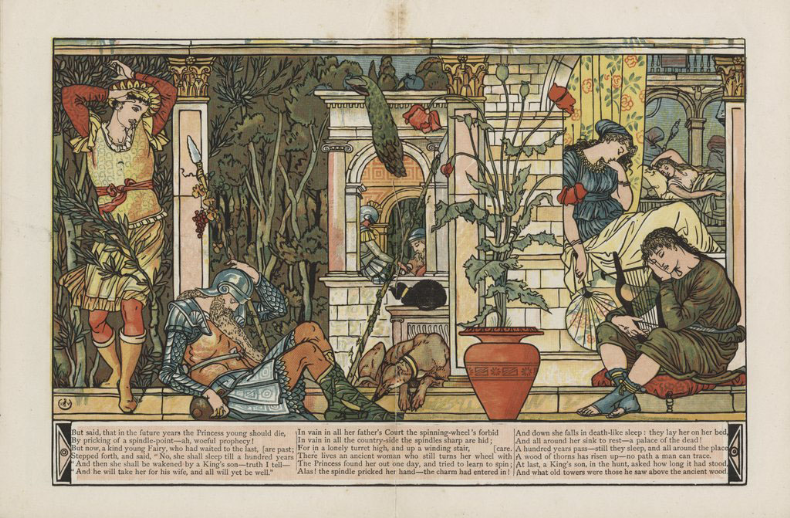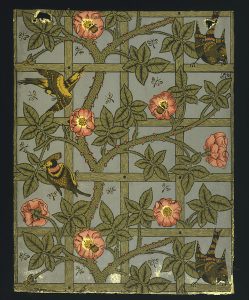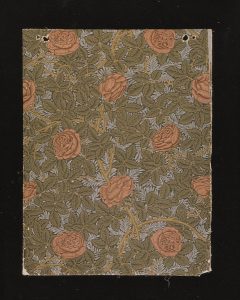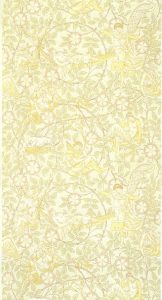Some Hints on Wallpaper Design
One of the goals of Home Subjects is to foster a consideration of how the exigencies of interior design in the past have created a framework through which we continue to understand, largely without realizing it, how design should function in contemporary society. According to shelter magazines, decorator blogs, and even HGTV, wallpaper is back. As designer Sefton Freeman-Bahn pointed out recently in the Guardian, “the possibilities wallpaper offers to create or change a space are amazing,” and many wallpaper designers have embraced digital printing in order to explore new techniques and finishes, as well as enhance the speed of production. Designer Linda Hasking takes these processes one step further, creating photographic collages and then digitally printing them as wallpaper.
It is a period of exploration and inventiveness in wallpaper design that recalls the pioneering work of William Morris and others in this field. What is lacking in the current moment–at least as it is reported in the press–is any sense of debate over the appropriateness of digital printing or the use of photographs in pattern design. As a way to provide some historical perspective on this wallpaper renaissance, it is interesting to consider the vigorous debate in the Arts and Crafts movement over the appropriate parameters for wallpaper design, including the use of the human figure in creating repeating patterns. Although this concern may seem esoteric today, it reveals the seriousness with which Morris and his Arts and Crafts colleagues approached wallpaper, especially when it came to establishing criteria for good design.
Morris discussed the symbolic potential of wallpaper in his lecture “Some Hints on Pattern-Designing” from 1881, stating that decoration is “futile” and degraded unless it reminds the viewer “of something beyond itself, of something of which it is a visible symbol.” However, he suggests that natural forms are the most appropriate inspiration for such work. One of Morris’s earliest and most popular wallpaper designs, Trellis, which he designed for his own home at Red House in 1862, uses the geometry of the garden trellis as the structuring principle for the grouping of roses, birds, and even the occasional bee. His later Rose pattern of 1876 again uses roses, but replaces the trellis with Morris’s signature “branch” framework for a repeating pattern, balancing symmetry and asymmetry in the same paper.
Morris’s friend Walter Crane also suggested that wallpaper could be visually and intellectually satisfying in his essay “On the Structure of Decorative Pattern.” Yet rather than focus on the potential of natural forms, he concentrates instead on the central role of figurative art in ancient religions: “the ancient religions of the world were nothing but figurative systems—personifications and symbols of the forces of nature.” The figurative element, he suggests, endures throughout history because it is based in human experience and on the human body. According to Crane, the mind naturally seeks out figurative art. The human figure conveys meaning in a way that recalls his previous discussion of allegory. Crane refers to “the mental vitality of art” as the “life-blood” that “circulates freely through the whole body of art.” And the human form becomes the allegorical agent.
In a series of published debates on the nature and use of ornament from 1902, Crane and the designer Lewis F. Day disagreed over the use of the human form in pattern design. Day found them “a disturbing influence” that could not be adequately conventionalized in a repeating pattern. Crane argued for the human figure as a formal element in pattern design, as its “forms give me certain lines and masses decoratively valuable and not obtainable by other means. They give life and movement in ornament.” Furthermore, elements of the human form can function as both image and emblem in pattern design since “by the use of such forms, also, symbolic meaning may be expressed (or concealed) fanciful allegory or playful ideas. In short, they make ornament more interesting and amusing.” And Crane makes clear here that figurative art conveys an “imaginative conception” through the human figure.
The interesting explorations of this theory of design are Crane’s so-called “nursery papers,” wallpaper designs that transform figures from his popular children’s book illustrations into units of ornament. He first suggested the decorative capacity of the human body to communicate meaning in a wallpaper design based on his Sleeping Beauty nursery book illustration from 1879. Like Morris’s Rose, Crane also uses the rose as the flower as the determining principle of the design. But here the energetic swirl of the rose branch that structures the wallpaper is a direct quotation from Crane’s illustration, identical to the pattern on the curtain that shelters the sleeping heroine.
Crane places figures from his illustration within this branch structure and orders them against this backdrop: we find Sleeping Beauty herself, her courtiers (including her aged father, the King), the old crone at her spinning wheel, and even the sleeping hound. The tail of a peacock falls just over the shoulder of the prince, making it appear at first glance that the prince has wings. The victorious prince emerges from the thicket to wake the sleeping princess, and the repeat of the wallpaper pattern imagines the event as a perpetual recurrence. One can imagine that this message is one that William Morris would have appreciated: the awakening of beauty, especially in the home. But for Morris the wallpaper would have failed as a pattern since it relied upon the human figure. For the most part, wallpaper designers today tend to avoid the use of the body in pattern design, although the possibility of photo-collage and digital printing raises new questions about the relationship between wallpaper and the real world.

Walter Crane, centerfold illustration to The Sleeping Beauty in the Wood (London: George Routledge and Sons, 1876), Beinecke Library, Yale University.
The decision to avoid the human form as a visual motif in pattern design in our contemporary society is probably meant to avoid the objectification that such as motif might entail, resulting in a pattern that is both unaesthetic and offensive to modern eyes. Contemporary wallpaper designers wanting to use the body within the context of a politically progressive modernist aesthetic would have to be very sensitive in a way that Morris would not have envisioned.
Those interested in learning more about wallpaper design in Britain will find a useful list of resources here, courtesy of the V&A.



